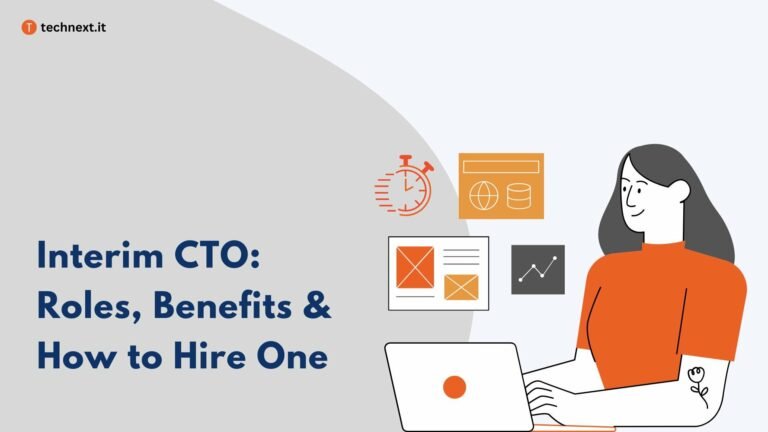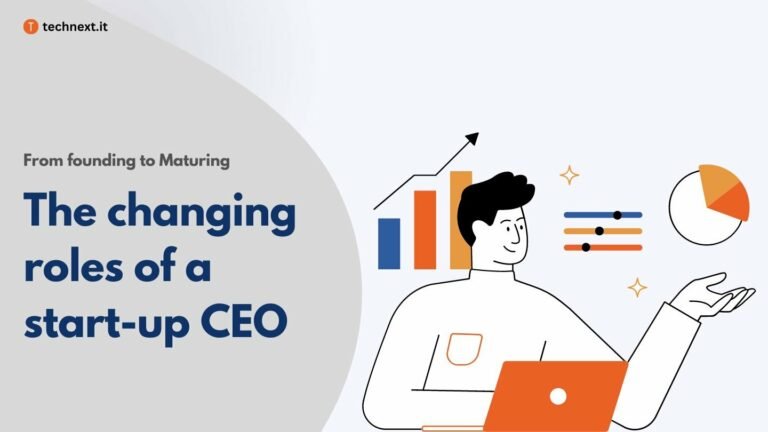A Complete Guide on How to Hire a Fractional CTO and Beyond
When you don’t have a full-time CTO, a fractional CTO is your go-to persona. But how do you hire a fractional CTO, what are the skills they must have, and how can you build an effective partnership and get the most out of it?

Effective leadership and optimal resource allocation are two absolutely crucial factors to achieving success in any business.
However, hiring quality leaders, particularly in the tech industry, can be costly. In the US, hiring a CTO may set businesses back by $300,000 annually, which not all companies can afford.
Need a way out of this paradox? The solution is simple: hire a fractional CTO. Unfortunately, the process of hiring a fractional CTO is not as simple. You need to find out the perfect candidates, interview them, hire and then form an effective collaboration.
Let’s discuss all the factors that will guide you on how to hire a fractional CTO perfect for your business needs.
Welcome to our Tech Leadership Series. Here, we’ll delve into the various leadership positions in the tech industry, their roles and responsibilities, how to become a tech leader, and tips on hiring tech leaders. Stay tuned for more valuable insights! Here are our previous articles
Startup CTO: Navigating the Challenges and Responsibilities
When Does Your Company Need a Fractional CTO?
Every business’s ideal moment of hiring a fractional CTO varies and depends on its own criteria. Some startups require a chief technology officer from the very beginning, while others require one when the business grows. Many startups don’t employ a CTO in the beginning because of the minor technical management responsibility that can be fulfilled by any capable employee.
But when you encounter several investors who are not ready to invest in your startup because you do not have a tech expert onboard. Or, you might come across investors saying – you don’t have any expert guidance in your company and lack compelling ideas. That case scenario should be the best time to realize that your business needs a fractional CTO.
Let’s forget all of those; the simple rule of knowing if you should hire a fractional CTO is “Realising the need.” If you feel your business would do better with solid tech leadership, then this is the right time to hire a CTO. And if you don’t have enough resources to hire a full-time CTO, hiring a fractional CTO is your answer.
Expert Tips: Consider hiring a fractional CTO if you:
- Need help building technology but lack a tech leader.
- Your team of developers lacks experience in making strategic decisions and requires more active management than you can provide.
- Need a technical expert to help solve a tech-related problem or work on a project?
Experience, Skills, and Qualifications Your Fractional CTO Should Have
As we said earlier, any fractional CTO is another technology leader and usually has equal, if not more, experience and skills than a full-time CTO. Honestly, working for multiple organizations at once often gives the upper hand in experience.
Don’t get me wrong; not everyone claiming to be an experienced fractional CTO can provide real value to your business. It’s your job to thoroughly check the experience, skills, and qualifications before you hire someone.
So, what should you access before hiring your fractional CTO?
Experience
It goes without saying that looking into people’s past work experiences is the easiest way to assess their abilities. What level of or how many years of experience does a fractional CTO need to have?
Typically, CTOs have roughly 15 years of experience in the IT area before being considered for the position. But years of work aren’t the only thing you should be looking for. Look at who they’ve worked with and what they’ve done while working for them.
Take Open AI CTO Mira Murati as an example; she does not have 15 years of experience yet she has achieved significant accomplishments.
Technical Skills
A CTO must be well-versed in a variety of technologies, so does an on demand CTO. Yes, as a leader, he doesn’t need to code or design the database, but the leader should have a good understanding of every technical aspect. His/her skills includes but not limited to:
- Strong knowledge of various programming languages and software development methodologies.
- Proficiency in designing and architecting complex software systems, including distributed systems, cloud infrastructure, and scalability considerations.
- Understanding of networking protocols, infrastructure management, cloud computing platforms, and virtualization technologies.
- Expertise in database technologies, such as SQL and NoSQL databases.
- Knowledge of information security principles, secure coding practices, vulnerability assessment, and risk management.
- Proficiency in data analysis, data visualization, and business intelligence tools.
- Familiarity with AI and ML concepts, algorithms, and frameworks.
- Knowledge of mobile app development frameworks, web development languages (HTML, CSS, JavaScript), and responsive design principles.
- Awareness of emerging technologies and trends in the tech industry, such as blockchain, Internet of Things (IoT), edge computing, and augmented reality (AR)/virtual reality (VR).
Business & Management Skills
You might think that a fractional CTO only handles development and technical aspects, but why are business and management skills necessary?
That is because the CTOs will be responsible for making important decisions for your company that will definitely greatly impact on business and management aspects. So, what does he need to know?
Strategic Planning: The ability to develop a technology strategy aligned with the overall business goals and objectives. This includes understanding the organization’s long-term vision, identifying technology opportunities, and creating a roadmap for technology implementation and innovation.
Leadership skills: Fractional CTOs typically work with teams. And to ensure a high level of productivity, a CTO should be able to motivate employees. To do this, a CTO has to delegate tasks while offering guidance and mentoring when needed.
Effective communication:
A CTO should have the ability to communicate with all stakeholders effectively. This includes communicating ideas, technical information, and solutions to problems. This involves a thorough understanding of the business and projects the CTO is working with.
Decision-making skills
One of the biggest responsibilities of a CTO is to make important decisions regarding teams, resources, tasks, and deadlines. The CTO can work on a strategy that includes all these points or work alongside the technical co-founder and other stakeholders to assist with advice when decisions need to be made.
Ability to conduct research
When new projects are launched, the CTO needs to be able to thoroughly research the business needs and which solutions are best suited. The CTO should also have the be ability to identify any possible challenges and find resolutions for them.
Strategic thinking skills
A CTO needs to think strategically to focus on the bigger picture of a business or project’s goals. It is one of the vital responsibilities of the CTO to lead a team of project managers, developers, and designers, while they focus on the details.
Time management skills
The responsibilities of the CTO can be so demanding that it is very important to have excellent time management skills. This includes setting up tasks, following timelines and meeting deadlines.
Ability to employ tech talent
A fractional CTO should have the skills to source and employ, or at least assess, new candidates. The CTO has the experience and knowledge to understand which candidates are right for certain positions and what type of skills they basically should have.
Communication and Presentation
Also, he/she should have the ability to communicate complex technical concepts clearly and concisely to technical and non-technical stakeholders. This includes preparing and delivering presentations, providing updates on technology initiatives, and facilitating effective communication across the organization.
How to Hire a Fractional CTO in 2023
Defining Your Expectations from a Fractional CTO
Once you come to a stage where you have decided you need a fractional CTO for your organization, then you must possess a few expectations from him to make him worthy in your company.
One of the primary expectations from a fractional CTO is to provide strategic guidance and direction for the organization’s technological initiatives. Nowadays CTOs manage all technical aspects of a firm and guide employees in developing the right products and technology that support the firm’s needs.
Besides that, you may also expect your fractional CTO should know how to build and lead a highly skilled technical team and how to possess excellent communication skills to effectively communicate complex technical concepts to non-technical stakeholders, enabling them to make informed decisions and understand the core value of technology investments.
Additionally, you may expect your fractional CTO must have experience in market analysis, identification of the best technology solutions, the direction of the company’s technical strategy, and evaluation of new technologies.
Whatever your expectations are, write them down. Break them into tasks if possible, and then understand how much time you need from the fractional CTO based on your requirements.
Finding the Right Candidates
When hiring for a fractional CTO position, posting circulars to get CVs is not an option. So, how can you find candidates?
Using personal and professional networks
As a founder, you are already part of a vast professional network. Spread the word that you are seeking an on-demand tech leader. If there are any interested candidates, they will reach out to you.
Take advantage of Linkedin
Linkedin is a powerful recruitment platform, so it is no surprise that 87% of recruiters utilize LinkedIn regularly. You can also use LinkedIn to find your potential candidates. Here’s how to get the most out of the LinkedIn platform and find the perfect candidates with less effort.
- Simply post your requirements on LinkedIn. If you have any interested candidates in your network, they will reach out to you.
- Another up-and-coming option is to join relevant groups. These groups usually consist of people who provide CTO as a Service or Fractional CFO services. Some groups even have a job section, allowing you to share your openings.
- If you ask me, the best way to utilize LinkedIn is to actively search for candidates using keywords. Use keywords like “CTO as a Service”, “Fractional CTO”, and “On Demand CTO” to find out the potential candidates who are offering these services. Additionally, use advanced filters to narrow down the list further.

Consider seeking assistance from agencies
Staff augmentation agencies allow other companies to hire CTOs as part of their CTO-as-a-service program. These services are relatively cost-effective options and perfect for you if you don’t mind hiring offshore.
For example, Technext allows you to hire tech leaders with 10+ years of experience for as low as $100/hr.
No matter what method you use to find your desired candidates, make sure you create a list of at least a few candidates before moving on to assessing their quality.
Accessing Qualifications: Interviewing, Checking Portfolios & References
The first step in assessing the quality of candidates is conducting interviews. You need to prepare a list of questions that are relevant to your problems, requirements, and expectations.
It’s important to note that interviewing a fractional CTO differs vastly from interviewing a software engineer. So, try to ask questions related to leadership, strategy, and execution. Also:
- Ask about their previous experience. Especially related to your case.
- Ask about managing teams and his/her experience in managing remote teams as well.
- How do you approach technology strategy and roadmap development?
- What approach do you take to cybersecurity and data privacy?
- Ask about scalability and system architecture.
- Important! During the interview process, ask them to complete a technical assessment.
Evaluating a candidate’s portfolio and references is another vital part of an interview session. It can help you assess their capabilities and the type of projects they’ve delivered in the past.
It can help you determine whether their experience matches your business needs. In other words, the potential candidate should have experience in your industry, or they should be quick to understand its unique needs and requirements.
Discussing The Engagement Terms
After interviewing, make sure you discuss engagement terms clearly so that both parties are on the same page regarding expectations and payment.
The discussion should cover various aspects, such as the scope of work, time commitment, duration of engagement, compensation and payment terms, confidentiality, communication and reporting, termination and dispute resolution, as well as non-compete and non-solicitation clauses, if applicable.
This pre-discussion is undoubtedly important because it has numerous benefits that contribute to a successful working relationship with your fractional CTO. By openly discussing the engagement term will help you align on the scope of work, responsibilities, and deliverables and help you avoid potential misunderstandings.
Besides that, it will enable you to foster a collaborative and transparent working relationship. At the same time will enable an opportunity to share insights, ideas, and perspectives between you and the fractional CTO. Most importantly, it will help you mitigate risks and clarifies important aspects of the engagement.
Making Hiring Decisions and Onboarding
Lastly, you need to make your onboarding decision based on the interview and quality assessment. Consult with co-interviewers or other colleagues in your organization before making a decision.
lear terms of engagement should be established and both parties should sign, regardless of duration. Seek legal assistance if necessary.
Building an Effective Partnership with the Fractional CTO
After completing the hiring process, it is important to establish a meaningful working relationship with your fractional CFO. How to do that?
Establishing Effective Communication and Collaboration
Communication is the key, miscommunication can lead you to catastrophe. So make sure you communicate early and communicate often with your fractional CTO.
5 key points to establish effective communication and collaboration with the fractional CTO.
- Clearly articulate your product mission and vision. Engage your fractional CTO about why you are doing it; not only what you are developing.
- Describe what you want to develop in the MVP or in that release. Make a phase-wise release checklist. Your fractional CTO can help you with this too.
- Make sure what the end goal looks like. Design a complete flow with the help of your UX/UI design. Try to create a clickable prototype. Iterate and reiterate in the UX design phase so there will be no surprise with the end result.
- What costs can you manage? Set a range you will afford or limit when to stop the spending. The CTOs are mostly perfectionists, which leads to more spending.
- And lastly, anything that might raise conflict should be discussed early.
Regular Evaluation and Feedback
Software is not static, it evolves over time. Technology upgrades, customer feedback, usability – those metrics can lead you to change and improve your solution.
To cope with the change, here’s what you might do –
- Use any project management tool like Jira, Trello, odoo, or ClickUp to see the progress.
- Use communication tools like Slack, Discord, or Telegram to communicate efficiently.
- Follow the sprint-wise development method for the development. Agile methods like Scrum and Kanban might be helpful for large projects.
- Test, test, and test; that’s how you make the best. Along with your testing engineer, you should often test in the staging server.
- Give regular feedback to the fractional CTO, and ask for advice and improvements.
Common Challenges of Hiring Fractional CTO & Solutions from the Expert
At Technext, we are providing CTO as a service in the US, Canada, Europe, the UK, and Australia. We have had great experiences so far. Still, there are some challenges when you hire a fractional CTO.
You might want to read the following challenges of hiring a fractional CTO and how to mitigate them.
Managing time
You hire a fractional CTO, not a full-time CTO. So there might be issues with managing his time with your team.
You can mitigate this problem by blocking a certain number of hours per week along with the exact time slot. Also, your fractional CTO might be from a different continent, you should keep the timezone checked.
Managing availability
You hire a fractional CTO who could be engaged with other startups and businesses. You cannot expect his full-time availability for you.
You need to understand and accept that your fractional CTO will be engaged with others, also. You can clearly set what you want when you want. That could solve this problem.
Scaling
You hire your fractional CTO at the early stage. If you become successful and start getting bigger with a lot of developers and customers, it will be tough to handle the scalability issue with the fractional CTO.
You can ask to document everything properly, ask him/her to join you as a full-time CTO, or hire another talent as your full-time CTO. Alternatively, you can build a scalable application from the very beginning.
I hope you liked this article on how to hire a fractional CTO. You may also like the following articles.
A Complete Guide to the Ideal Tech Startup Team Structure
A Complete Guide to Ideal Startup Marketing Team Structure
How to Split Equity in a Startup Fairly in 2022
From Idea to IPO: The 5 Stages of Funding for Startups
How to Hire Developers for a Startup
A Complete Guide to the Ideal Tech Startup Team Structure
In-house Development vs Outsourcing: Guideline for Founders
Best of Luck!






